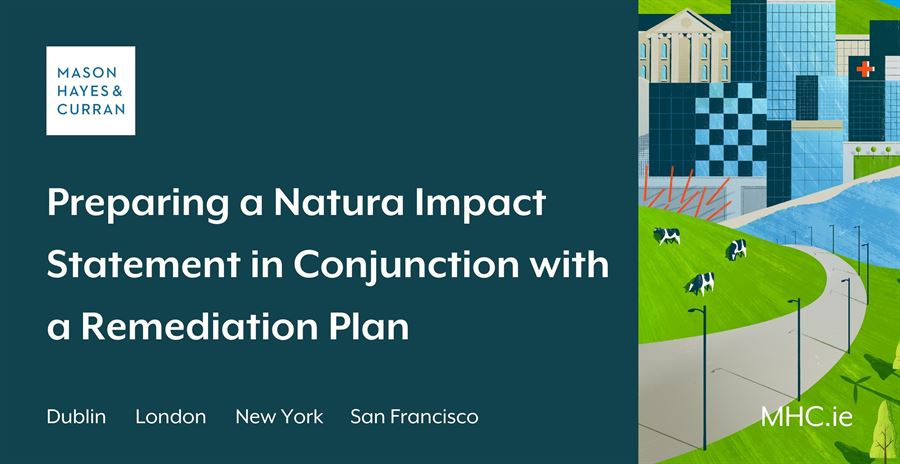
This case concerned an illegal dumping site in Co. Wicklow which began in 1979. The County Council closed the site in 2001 after it was purchased by a subsidiary of the current owners Brownfield Restoration Ireland Ltd. An application was made by Brownfield to the Environmental Protection Agency (EPA) back in 2005 and a license was granted to remediate the site requiring it to remove all waste and contaminated soil within 3 years. The Council took proceedings against 12 parties for full remediation of the site. However, it turned out that the Council itself had been responsible for a considerable amount of the illegal dumping. On becoming aware of this fact, Brownfield issued proceedings in the High Court to require the Council to remove the waste and remediate the site in 2008.
This is the 11th High Court judgment on this matter. In May 2017, the Court decided the EU law issues including that appropriate assessment (AA) is not required where the Court directs remediation. In July 2017, remediation was ordered, and the Court further set out a 15-step indicative timeline. A final date of 19 January 2024 was set for full remediation by the Council and handover which is binding. A direction was given by the minister to carry out the AA. The Council did not dispute the matter and furthermore the Court allowed the Council to engage in a process along the lines of AA, despite an earlier ruling that an AA would not necessarily be required.
The Current Decision
In the decision at hand, the Court turned its attention to deal with the implementation of existing orders. It went on to discuss the Council’s motion to approve a methodology of removal under the EPA code of practice. Brownfield maintained that the Council had been ignoring previous judgements and orders. They claimed that instead of working on the methodology directed by the Court, the Council were going back over old ground which had already been the subject of a definitive order after lengthy and hotly contested proceedings on oral evidence. In light of this, the Council decided not to proceed with its motion. It decided instead to move straight to the remediation plan. Although a lot of time had passed, the Court expressed the view that should the final date not be met in 2024, orders may take account of the stalling or delaying of implementation at the outset by the Council.
Matters developed based on preparing a remediation plan until 15th March 2021 when Minister for Tourism, Culture, Arts, Gaeltacht, Sport and Media, Catherine Martin, directed the preparation of a Natura Impact Statement pursuant to reg. 42(19) of the European Communities (Birds and Natural Habitats) Regulations 2011 (S.I. No. 477 of 2011). The Court had to decide whether further specific directions were required in light of that intervention. At this time, matters stood at step 5 of 15, the circulation of a draft remediation plan.
The Council proposed steps 6-8 should include:
-
the completion of biodiversity surveys to provide the Natura Impact Statement (NIS) by the end of March 2022
-
submission of the NIS by 29 April 2022, and
-
circulation of the draft remediation plan to the EPA and Brownfield plus consultees to whom the original draft plan was circulated at Step 5 by 29 July 2022.
Finally, the Council proposed that step 8 should see the finalisation of the final draft of the remediation plan. It added that if necessary, preparation of a Scott schedule for submission to the Court by 29 September 2022 where parties cannot agree matters should be included.
No objection was raised to the proposed timeline or the revisiting of whether an AA should be required despite the earlier decision on same. The only issue raised by Brownfield was whether the assessment report should be finalised before the draft plan or only when the draft remediation plan had been prepared. The Court did not see this as a fundamental objection. It felt the best way to move things along was by giving a direction always keeping in mind that Brownfield must be given the opportunity to review and consider objections to any specific steps proposed by the Council.
Order
An order was made on 29 July 2021 that, firstly, the Council is to complete the biodiversity surveys required for the preparation of a Natura Impact Statement by 17 December 2021. Secondly, that the matter be listed for mention on 11 October 2021 to facilitate the parties to consider whether the subsequent steps and timelines proposed by the Council are acceptable, and in the event that they are not, to fix a date for a hearing to finalise those steps.
Conclusion
The case is another turn in the long saga of the Brownfield Restoration cases which have decided, amongst other things, allocation of responsibility for remediation and the standard of remediation required.
Although Justice Humphreys previously held an Appropriate Assessment is not required where the Court directs remediation, Minister Martin directed the Council to prepare a Natura Impact Statement for the remediation works. The Council did not challenge the Minister’s direction and instead considered how to integrate this process into the remaining steps of the remediation plan. The Council now must complete the biodiversity surveys by 17 December 2021, with a view to ensuring compliance with the final deadline for the remediation to be completed in 2024.
For more information, contact a member of our Real Estate team.
The content of this article is provided for information purposes only and does not constitute legal or other advice.



